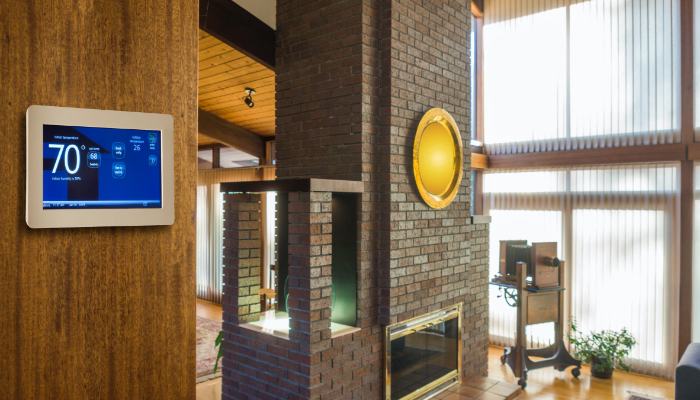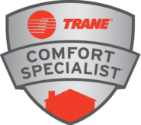Zoned HVAC Systems: Customized Comfort for Your Wallingford, CT Area Home or Business
Are you struggling with uneven temperatures throughout your home or business? X-Treme Temp Heating and Cooling, LLC offers expert solutions with advanced zoned HVAC systems that provide personalized comfort and energy efficiency for your needs.
Unlock Your Home or Workplace's Perfect Comfort Zone – Beat the Temperature Rollercoaster Now! 🌡️🏠 X-Treme Temp has your ultimate comfort solution!
203-815-6851 or Contact Online Now and Transform Your Home's Comfort in Just One Visit!🔥 Home Comfort Assessment ❄️ Custom Zoning Solutions 💡 Energy Savings
Zoned System FAQs
A zoned HVAC system saves energy by directing heated or cooled air only to the areas that need it, rather than conditioning the entire home at once. This targeted approach reduces energy waste, lowers utility bills, and enhances comfort. Here’s how it works:
1. Customized Temperature Control
With traditional HVAC systems, the entire home is maintained at one temperature, even in rooms that aren’t being used. A zoned system divides the home into multiple zones, each controlled by its own thermostat. This means:
- You can reduce heating or cooling in unoccupied rooms.
- Different areas of the home can be set to different temperatures, preventing unnecessary energy use.
2. Reduced HVAC Run Time
Since a zoned system only conditions specific areas as needed, it doesn’t run as frequently or for as long as a traditional system. Less runtime means:
- Lower energy consumption since the system isn’t working as hard.
- Reduced wear and tear on HVAC components, extending their lifespan.
3. More Efficient Air Distribution
Zoned HVAC systems use motorized dampers in the ductwork to control airflow. These dampers open and close as needed, ensuring that conditioned air goes only where it’s required. This prevents:
- Energy loss from over-conditioning unused rooms.
- Hot and cold spots, improving comfort without overworking the system.
4. Integration with Smart Thermostats
Modern zoned systems often work with smart thermostats and automation technology, which optimize heating and cooling based on:
- Time of day (e.g., reducing cooling at night in unoccupied rooms).
- Occupancy sensors that adjust settings automatically.
- Weather conditions, ensuring minimal energy use while maintaining comfort.
5. Improved Efficiency in Multi-Story Homes
Homes with multiple levels often experience temperature imbalances due to heat rising. A zoned system:
- Keeps upper and lower floors at separate temperatures, preventing overcooling or overheating.
- Reduces strain on the HVAC system by only heating or cooling the level that needs it.
6. Lower Energy Bills & Environmental Benefits
By only conditioning the necessary areas of a home, a zoned HVAC system can reduce energy bills by up to 30%. Additionally:
- Lower energy consumption reduces carbon footprint.
- Less HVAC strain means fewer repairs and replacements, reducing waste.
Conclusion
A zoned HVAC system is one of the most effective ways to reduce energy waste while enhancing home comfort. By customizing temperature control, reducing HVAC run time, improving air distribution, integrating smart technology, and optimizing multi-story home efficiency, zoned systems help homeowners save money and energy while extending the life of their HVAC system.
Yes! A zoned HVAC system can work with a smart thermostat, but compatibility depends on the thermostat model and the zoning setup. Integrating smart controls with zoning enhances energy efficiency, comfort, and automation. Here’s how:
1. Compatibility with Multi-Zone Systems
Most modern smart thermostats, like Nest, Ecobee, and Honeywell, are designed to work with single-zone systems. However, for multi-zone HVAC setups, you may need:
- A smart thermostat for each zone to individually control different areas.
- A central zoning panel that communicates between the HVAC system and thermostats.
- Smart sensors to detect occupancy and temperature differences for better control.
2. Automated Zone Control
Smart thermostats optimize zoned heating and cooling by:
- Adjusting temperatures based on occupancy, so unused rooms aren’t over-conditioned.
- Creating schedules for each zone (e.g., keeping bedrooms cooler at night while the living room stays warmer during the day).
- Using geofencing to change settings when you leave or return home.
3. Integration with Motorized Dampers
Zoned systems rely on motorized dampers within the ductwork to control airflow to different areas. When paired with smart thermostats, these dampers:
- Open or close automatically based on temperature settings.
- Prevent energy waste by directing air only where it’s needed.
- Eliminate hot and cold spots for consistent comfort.
4. Smart Thermostat Brands & Zoning Compatibility
Some smart thermostat models are better suited for zoned systems. Here are a few examples:
✅ Ecobee SmartThermostat – Works with remote sensors to adjust temperature per zone.
✅ Honeywell T10 Pro – Designed for multi-zone compatibility with smart sensors.
✅ Nest Learning Thermostat – Can control zones but may require multiple units.
✅ Aprilaire 8820 – Specifically built for HVAC zoning control.
5. Energy Efficiency & Cost Savings
By integrating smart thermostats with zoned HVAC, homeowners can:
- Reduce energy waste by conditioning only occupied spaces.
- Save up to 30% on energy bills with precise temperature control.
- Extend HVAC system lifespan by preventing unnecessary strain.
6. Voice & App Control for Maximum Convenience
Many smart thermostats integrate with Alexa, Google Assistant, and Apple HomeKit, allowing homeowners to:
- Adjust temperatures by voice (e.g., "Set the bedroom to 72°F").
- Monitor energy usage and make efficiency adjustments via smartphone apps.
- Receive maintenance alerts when the system needs servicing.
Conclusion
A zoned HVAC system can work seamlessly with smart thermostats, but choosing compatible models and proper zoning setup is key. By combining automated dampers, smart sensors, and Wi-Fi-connected thermostats, you can enjoy personalized comfort, lower energy bills, and hands-free temperature control.
Yes, most zoned HVAC systems require multiple thermostats to control different zones independently. However, the exact number depends on the system setup, home size, and type of zoning technology used. Here’s how it works:
1. How Zoned Systems Use Thermostats
A zoned HVAC system divides a home into separate climate-controlled areas, each with its own thermostat. These thermostats:
- Measure the temperature in their assigned zone.
- Communicate with the zoning panel, which tells the HVAC system where to send conditioned air.
- Control motorized dampers, opening or closing them to adjust airflow for each zone.
2. Do You Always Need a Thermostat for Each Zone?
Not necessarily! There are two main ways to control zoned systems:
✅ Multiple Thermostats – Each zone has its own dedicated thermostat.
✅ One Smart Thermostat with Sensors – Some systems use remote temperature sensors instead of multiple thermostats, adjusting airflow based on sensor readings.
3. Using Smart Thermostats & Sensors
Modern smart thermostats like Ecobee, Nest, and Honeywell T10 can control multiple zones by:
- Reading temperatures from remote sensors placed in different areas.
- Automatically adjusting airflow based on where you spend the most time.
- Reducing the need for multiple wall-mounted thermostats while still maintaining zoning benefits.
4. How Many Zones Can I Have?
Most residential HVAC zoning systems support 2 to 8 zones, depending on:
- Home layout – Larger homes benefit from more zones.
- HVAC capacity – Your system must be able to handle multiple zones efficiently.
- User preference – More zones mean more control but may require additional thermostats or sensors.
5. Benefits of Multiple Thermostats for Zoning
Having a thermostat in each zone allows for:
✔️ Independent temperature control in each area.
✔️ More precise comfort by targeting specific rooms.
✔️ Better energy efficiency, since only necessary zones are heated or cooled.
✔️ Reduced HVAC system strain, preventing overuse and lowering energy costs.
6. What If I Only Have One Thermostat?
If your home currently has one thermostat, you may still be able to add zoning by:
- Installing a smart thermostat with remote sensors for multi-room control.
- Upgrading to a zoning panel system that works with dampers and multiple thermostats.
- Consulting an HVAC professional to determine the best zoning setup for your home.
Conclusion
Most zoned HVAC systems work best with multiple thermostats, but smart thermostats with sensors can sometimes reduce the need for extra units. The right setup depends on your home’s size, HVAC system, and zoning needs. For maximum comfort and efficiency, consult an HVAC expert to determine the best thermostat solution for your zoned system.

What Are Zoned HVAC Systems?
Zoned heating and cooling systems are innovative solutions that divide your home into multiple temperature zones, allowing precise control over individual room or area temperatures. Unlike traditional HVAC systems that treat your entire home as a single space, zoned systems provide customized comfort where you need it most.
Benefits of Zoned HVAC Systems
Homeowners in the Wallingford, CT area can experience significant advantages with zoned systems:
- Personalized Temperature Control
- Improved Energy Efficiency
- Reduced Utility Costs
- Eliminates Hot and Cold Spots
- Enhanced Comfort for Different Household Needs
- Extended HVAC System Lifespan
How Zoned HVAC Systems Work
Our expert technicians can design a zoned system tailored to your home's unique layout:
- Strategic Temperature Zone Mapping
- Installation of Multiple Dampers
- Precision Thermostats for Each Zone
- Advanced Control Systems
- Seamless Integration with Existing HVAC Infrastructure
Ideal Scenarios for Zoned HVAC Systems
Zoned systems are particularly beneficial for:
- Multi-Level Homes
- Houses with Large Windows
- Homes with Open Floor Plans
- Spaces with Varied Sun Exposure
- Families with Different Temperature Preferences
- Rooms with Unique Heating or Cooling Challenges
Why Choose X-Treme Temp for Zoned HVAC Solutions?
Our comprehensive zoned system services include:
- Free Home Comfort Assessments
- Custom Zoning Design Consultations
- Professional Installation
- Energy Efficiency Evaluations
- Ongoing Maintenance and Support
- Cutting-Edge HVAC Technology
Zoned System Technology Options
We offer multiple zoning solutions to match your home's specific needs:
- Ducted Zoning Systems
- Ductless Mini-Split Zoning
- Hybrid Zoning Approaches
- Smart Home Integration
- Retrofit Zoning for Existing HVAC Systems
Ready to Transform Your Home's Comfort? 203-815-6851 or Contact Today Online for Zoned HVAC System Quotes and Expert Consultation!
X-Treme Temp Heating and Cooling specializes in delivering innovative HVAC solutions that maximize your home's comfort, efficiency, and performance. Our expert technicians are ready to help you explore the benefits of zoned HVAC systems tailored specifically to your Wallingford, CT area home.

